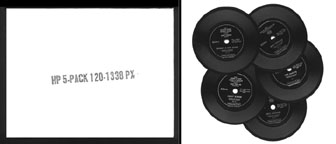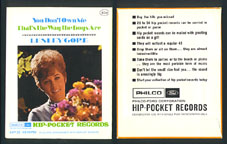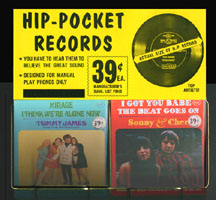|
COLLECTORMANIA!
Hip Pocket Records: Lighter Than Air
By Chuck Miller
It was almost like finding a prize in a box of cereal. You bought a music magazine, and inside
was an honest-to-goodness record. Not a vinyl or styrene record, mind you - a flexi-disc that
could bend or twist as the mailman jammed it in your post box. That's how most of us found
those original soundsheets - in everything from Mad to Trouser Press to Keerang! Sometimes,
the mail would contain Evatone soundsheets for the latest multi-disc set from the Longines
Symphonette society (I still have their "Golden Age of Radio" 12-disc set; I record those vinyl treasures on cassette and use them for long family trips in the car).
Well, back in the late 1960's, the electronics division of the Ford Motor Company, Philco, decided to mass-market flexidiscs of Top 40 hits. The discs, called "Hip-Pocket Records," cost 69 cents
for two songs (some discs were offered free as part of promotions for Gleem toothpaste or Head
& Shoulders), and featured the hitmakers of the day. Between 1967 and 1969, Philco/Ford
produced over 40 different titles - and depending on the artist, are worth anywhere from $5 to
$15 dollars apiece in mint condition, with an extra $5 to $10 with an intact sleeve.
Initially, Philco/Ford got their music from three record companies - Atlantic, Mercury and
Roulette, as well as their subsidiary labels like Bang and Atco. Smaller labels joined up in 1968, including Scepter, Double Shot, Phil-LA of Soul and Mala. They even produced a specially-designed phonograph (the Philco Miniature Radio Phonograph, model S-1379GR, with
built-in AM radio, 10" long when closed, 12" with handle extended, capable of playing Hip
Pockets as well as standard 45's and 33's).
Russ from Atlanta sent me this memory of Hip Pocket Discs: "The Hip Pocket Records originally sold for 69 cents - I think it was in the mid to late 60's. If I am remembering correctly, the only place I ever saw them was at Woolworth's dime store."
"The record jackets are printed paper envelopes, approximately 6 1/4 inches tall by 5 inches wide. There is a lightweight cardboard insert inside. They open from the bottom (odd?). The back of #25 reads like this:
Buy the hits you missed
25 to 50 hip pocket records can be carried in pocket or purse
Hip pocket records can be mailed with greeting cards as a gift
They will outlast a regular 45
Drop them or sit on them...they are almost indestructible
Take them to parties or to the beach or picnic...they are the most portable form of music
Don't let the small size fool you...the sound is amazingly big
Start your collection of hip pocket records today.
"The actual record is made of a very thin, flexible plastic or vinyl. It is just short of 4 inches in diameter. The records are 45's, and could be played on single play phonographs only. I played them on a Philco "Mini Radio Phono" (9 1/4 inches by 5 1/2 inches), which could also play standard 45's and even 33's. Yes, I still have it."
All the songs were mono mixes - in most cases, that meant combining both left and right stereo channels. Some Hip Pocket releases, though, had entirely different mono mixes, most notably Neil Diamond's "Solitary Man" (HP-17), whose mono version didn't appear again until a 1992 CD box set.
The sleeves themselves were nothing more than a listing of the two tracks and a stock photo of the artist or band; but even in that framework some artistic gems are discovered. The Doors' "Light My Fire" (HP-9) shows a transparent Jim Morrison superimposed over the faces of his bandmates. Tommy James' "I Think We're Alone Now" (HP-1) shows him with a trio of comely cuties (folks, I don't think these are the Shondells). John Fred's "Judy In Disguise" (HP-25) shows the band in an elegant stained-glass motif. And the releases by the Five Americans (HP-10) and Keith (HP-20) could arguably be called their "Greatest Hits" collections.
Be aware that some of the records do not contain the original recordings - most notably Chuck Berry's copy of "Maybelline" / " Roll Over Beethoven" (HP-34), are not the Chess originals, but rather Mercury re-recordings.
During Philco/Ford's two-year production of Hip-Pockets, another company tried to market
flexidiscs of popular artists. This company, Americom, hoped to set up a series of vending
machines that could pop out a flexidisc the way a cigarette machine pops out Winstons. And they had the biggest artists of the 1960's - the Beatles - as their drawing card.
Americom's Beatles line included not only the Fab Four, but many artists on Apple, including the Iveys, Billy Preston and Mary Hopkin. The records themselves were monochrome flexidiscs - instead of a yellow-orange Capitol swirl or a green ready-for-picking Apple label, these discs had a simple white logo on a black background - the flexidisc Apple looked closer to its computer trademark counterpart than to the Beatles logo.
While Philco had colorful sleeves and were available at your local Ford dealer and Woolworth's store, the Americom flexidiscs were available only in vending machines and came in a generic Pocket Disc sleeve. But due to its association with the Beatles catalog, Americom's discs are highly prized by collectors. Commons can run up to $200 in mint condition, and two titles - a "Yellow Submarine" printed on blue plastic (M-unknown) and "Get Back" (M-335) can be worth more than $1,000 in mint condition.

Chuck Miller, who wrote the above Hip Pocket Records article for his
Collectormania! column in Goldmine, has archived many of his stories and
interviews on his personal homepage. You can access it by clicking on the graphic above.
| 












